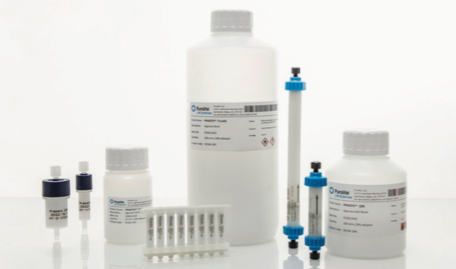
Pre-activated Resins for Ligand Immobilization to Facilitate the Creation of Customized Affinity Purification Media
Introduction
In the development of biopharmaceuticals, there are times when an off the shelf affinity chromatography medium is unavailable or isn’t highly selective for the target molecule being purified. It is possible then to design a custom chromatography solution by coupling a specific ligand to a pre-activated resin.
To enable the development of customized affinity purification media, Purolite has recently launched three pre-activated resins for ligand immobilization. The resins, Praesto NHS, Praesto CNBr, and Praesto Epoxy and are well suited for research, diagnostic and academic applications and are available in three particle sizes – 45μm, 65μm and 90μm.
The ability to create custom affinity purification media enables rapid scale-up from R&D proof of concept to larger-scale bioprocess production columns. In addition, a wide range of resins maximizes facility productivity and can improve process economics significantly.
When to use each
Praesto NHS
Praesto NHS resins couple ligands which have a primary amine. Praesto NHS incorporates a spacer chain, which separates the ligand from the chromatography matrix enabling maximum accessibility to the ligand.
The pre-activated NHS resin forms a stable amide linkage between the matrix and ligand resulting in very low ligand leakage and high caustic stability. A common application for NHS resins is immobilization of antibodies to create immunosorbents.
Praesto CNBr
The use of cyanogen bromide (CNBr) pre-activated base matrices is a well established, rapid and familiar technique for the coupling of bio-specific ligands to generate affinity chromatography purification media. This choice of pre-activation chemistry is well suited for research, diagnostic and academic applications. Coupling is via primary amino groups. Praesto CNBr resins have a cyanogen-active group, which form an isourea linkage between ligand and resin. The CNBr method has been used for over thirty years in Protein chemistry and there is thus a large number of literature references available. CNBr is frequently used for larger ligands and provides an alternative to NHS.
Praesto Epoxy
Praesto Epoxy resins offer the versatility to couple ligands through primary amine, hydroxyl and thiol groups. The Praesto Epoxy resin design incorporates a spacer, which separates the ligand from the chromatography carrier enabling maximum effciency of the ligand. The epoxide group forms a stable linkage between the matrix and ligand, resulting in very low ligand leakage and high caustic stability(if the ligand is stable). Proteins or molecules with available cysteines are readily immobilized using this technology
Matrix Characteristics
The Praesto NHS, Praesto CNBr, and Praesto Epoxy range of pre-activated chromatography resins use a modern, highly cross linked-agarose matrix formulation. Due to the unique rigidity and open pore structure of the Praesto agarose base beads, the Praesto pre-activated chromatography resins are well suited for process scale chromatography to allow large columns to be operated.

Praesto Pure90, Praesto Pure 65, Praesto Pure45 were packed at 4 bar to a bed height of 20 cm in a HiScaleTM 26/40 column.
Sepharose 6 Fast Flow and Sepharose 4 Fast Flow were packed at 2 bar to a bed height of 20 cm in a HiScaleTM 26/40 column.
Figure 1 shows the pressure flow comparison against Sepharose 4 Fast Flow (90 μm) and Sepharose 6 Fast Flow (90 μm). Even at process scale, with larger diameter columns and bed heights, the rigidity of Praesto allows at least 100% higher linear flow velocity. The ability to run at high flow rates increases productivity and improves facility throughput. (Figure courtesy of Purolite)
For more information, please see:
